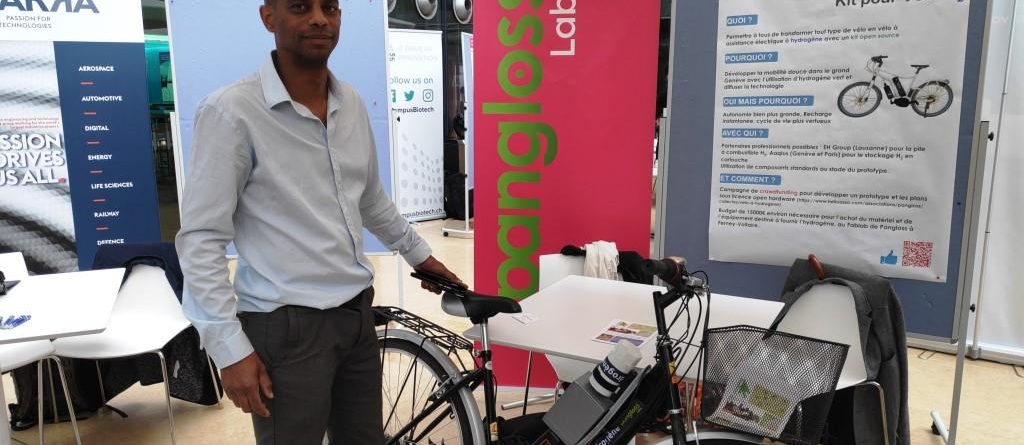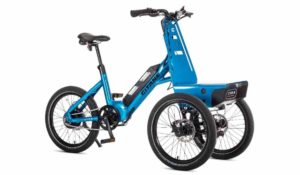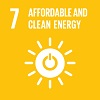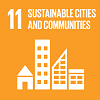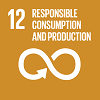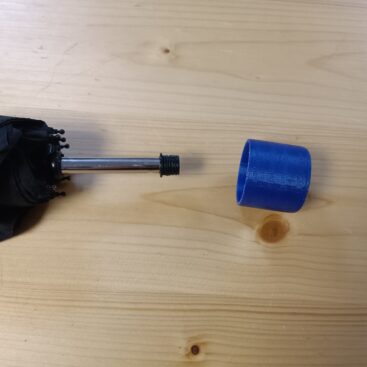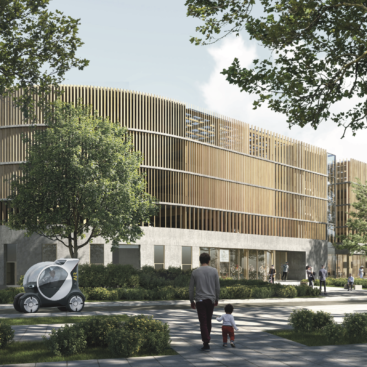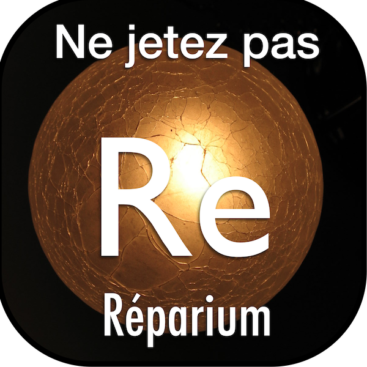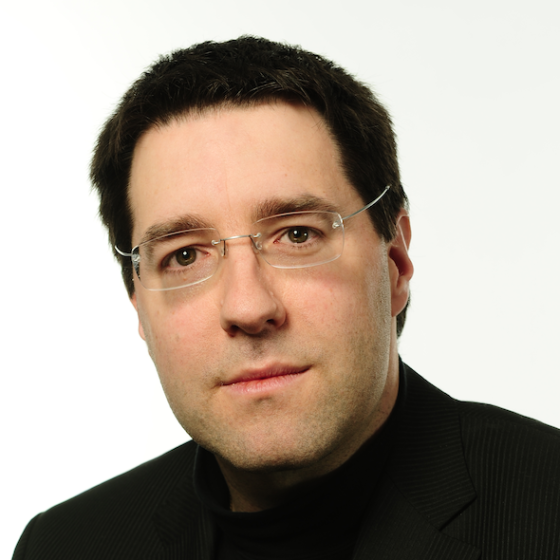Kit pour Vélo H2 – Project status
Conversion kit for hydrogen bicycle
Project status
The components of the hydrogen bicycle are all available and have been tried. The bicycle was run on hydrogen at the Science Festival 2021History
Octobre 15, Science and Biodiversity Festival 2022
The hydrogen bicycle ist shown in the parc of the Château de Voltaire at Ferney-Voltaire.November 24th, 2021 : Instagram #panglosslabs
Many thanks to Silvia Fabiani for One Minute of Fame on Instagram.October 9th, Science Festival 2021
The complete system is presented in the parc of the Château de Voltaire at Ferney-Voltaire. Visitors could pedal the bicycle mounted on a stand.
October 5th, 2021 : it moves in the lab.
Link to a short movie : 2021-10-05 first movesJuly 2021 The controller of the hydrogen bicycle takes shape
Charles and Paul are finalizing the processor for the hydrogen bicycle. A ESP 32 microcontroller unit reads various current sensors and controls the fuel cell.22 June 2021 refuelling a small bottle
Refuelling the hydrogen bicycle remains a challenge. We finally decided to work with pressurized hydrogen in a 2 litres bottle for storage on the bicycle. With a few OTS components we were able to fill the small bottle from a larger bottle.10 Oct. 2020 Science Festival
Fuel cell, hydrogen bottle and controls with buffer batterie all fit into a box which can be mounted on the bicycle. The box with compartments for the various components was 3D printed in the FabLab.
12 Oct. 2019 Science Festival
For demonstrations, Klaus exploses ballons filled with air, butane and hydrogen.
Crowd Funding (May to Oct. 2019)
We were looking for fifteen thousand euros but in the end got only 2500 euros. With the money we bought a Horizon H100 fuel cell for approximately 1500 euros (incl. taxes and shipping) as well as a 15 litres hydrogen cylinder at 200 bar from Linde for rent and various other components.
28 May 2019 OpenGeneva Innovation Festival
Harald and Olivier present the bicycle which has been equipped with an electric motot and models of fuel cell and hydrogen container.
23 Mar. 2019 Pangloss labs Open Innovation Festival
A day of reflections and activity. We thought of getting a bicycle from the bicycle pound in Geneva (http://www.fourriere-velo-ge.ch/ : "Our bikes are between 100 and 200 CHF depending on their condition") but then Klaus found a little-used one in his cellar. The association Pangloss Labs provided us with a conversion kit with pedal motor (Bafang 8FUN, BBS-01 250W pedal motor conversion kit; approx. €450). A battery is not included in the kit.12 Jan. 2019 Pangloss Hackathon “How to make a Hydrogen Bicycle.”
The bicycle should be a donation by one of the group members and the bicycle’s crankset motor BAFANG BBS01 will be a contribution from the Pangloss Labs association.
18 Oct. 2018 Meeting GE mobilité H2
Pangloss Labs participates in the Meeting GE mobilité H2 in Geneva.13 Oct. 2018 Science Festival
The idea is presented at the 2018 Science Festival in the Château de Voltaire at ferney Voltaire.
18 Sep. 2018 Visit Atawey, Chambery
Harald, Klaus and Olivier visit Atawey, manufacturer of hydrogen refuelling stations. Atawey has a hydrogen bicycle. Harald had a ride on it.
7 Sep. 2018 Réunion H2 Leman
Following the Open Geneva Hackathon, a group of people intersted in hydrogen think about what actually could be done. The idea to develop an open source kit for converting a bicycle into a hydrogen powered electric bicycle is born.9-15 April 2018 Open Geneva Hackathon
This weekend’s Pangloss Hydrothon as one of the Open Geneva Hackathons ended with the Hackshow at HEAD on Sunday. Paul did a great job getting our Pangloss Hydrothon converge into a poster which was presented at the Hackshow. The last item at the Hackshow was a Thank You to the organizers. Thanks again, Paul.Kit de conversion Vélo H2
Soutenez le développement d'un kit de conversion de vélo H2.

Faire un don : https://www.helloasso.com/associations/pangloss/collectes/velo-a-hydrogene/don
Développement d'un kit de conversion «open source» pour transformer un vélo «classique» en vélo électrique à hydrogène
Il s’agit de quoi ?
- Nous proposons de développer un kit de conversion «open source» pour transformer un vélo «classique» en vélo électrique à hydrogène.
- Dans le projet proposé nous créerons une infrastructure pour l’hydrogène au sein du FabLab de Pangloss Labs et nous construirons un prototype de vélo électrique à hydrogène avec des composants « off the shelf».
- Nous prévoirons la présentation du vélo H2 au Fête de la Science à Ferney-Voltaire en octobre 2019.
Pourquoi ?
Nous voulons inciter l’utilisation d’hydrogène vert par les particuliers et ainsi promouvoir les énergies renouvelables.
Nous voulons créer, dans le Pays de Gex et le Bassin Lémanique, une première cellule de compétence autour de l’hydrogène complémentaire de l’électricité verte.
Nous voulons contribuer à développer la mobilité douce dans le grand Genève, notamment dans un territoire très impacté par les déplacements pendulaires frontaliers relativement courts.
Quels avantages ?
- Notre kit ouvrira l’utilisation de l’hydrogène à tous et visera une flexibilité permettant de couvrir un maximum de situations de conversion.
- L’autonomie du vélo sera plus importante que sur les vélo électriques car l’hydrogène permet plus de stockage d’énergie sur le vélo. Elle ne sera d’ailleurs plus réduite par la température extérieure.
- La recharge est limitée à quelques minutes. La distribution d’hydrogène (cartouches ou gaz à la pompe) reste à préciser.
- Dans le cycle de vie du produit, les déchets ultimes dangereux provenant des piles sont fortement réduits.
Porteurs de projet et partenaires ?
Pangloss Labs est très engagé dans des projets pour initier l’économie de l’hydrogène, notamment dans le Grand Genève, à travers ses activités dans le cadre d’Open Geneva, sa participation à la Fête de la Science et au Mobility Hub du Grand Genève
 |
 |
 |
| Harald Wirth | Klaus Röhrich | Olivier Eugene |
| Physicien qui rêve de la transition énergétique vers l’hydrogène vert |
Physicien avec idées et idéals |
Ingénieur passionné des vélos |
Marché et opportunités commerciales
- Actuellement, il n'y a que très peu de fabricants de vélos à hydrogène, et un vélo H2 coûte près de 7.000 €.
- Le kit à un prix cible (les composants produits en petite série) bien inférieur à 2.000 € est destiné aux particuliers, mais aussi aux petits ateliers (tiers lieux, ateliers d'insertion, etc.). En plus des vélos de ville, le kit sera utilisable également sur d’autres types de vélos (tricycles, vélos cargos, long tails, etc…)
- L’opportunité d’affaires importante réside dans la distribution et l’échange des containeurs H2. Avec une infrastructure d’approvisionnement en hydrogène le marché est énorme, regardant p. ex seulement les déplacements pendulaires.
- L’introduction du kit sous licence « open hardware » aidera à arriver plus rapidement à une taille de marché d’importance pour la production des composants ainsi que pour des services liées.
Nous cherchons 15.000 €
Nous avons accompli des recherches préliminaires, regardé ce qui est sur le marché et visité des entreprises et participé à des salons. Nous avons réalisé la conversion d’un vélo « normal » en vélo électrique, en « hackant » des pièces disponibles dans le commerce (p. ex pour outils de jardin).

Les fonds nous permettrons d’aboutir, dans une année, à un prototype d’un vélo à hydrogène suivant les étapes suivantes :

- Création d’une espace chez Pangloss Labs pour travailler avec de l’hydrogène, équipement de maniement des gaz et électronique de contrôle
- Ajout d’un conteneur d'hydrogène et une pile à combustible au vélo. En ce qui concerne le conteneur H2 et la PAC, nous envisageons une collaboration avec des entreprises spécialisées.
- Simulations (p. ex modélisation sur OpenModelica) pour dimensionner le système optimal.
- Construction du vélo, optimisation des composants (impression 3d, assemblage dédié de la batterie tampon et de la pile à combustible, etc.)
- Démonstration du prototype. A ce stade, un premier produit utilisable devrait être disponible sous licence ouverte, en utilisant des composants disponibles dans le commerce, des pièces imprimées 3d et des logiciels spécifiques.
Les récompenses
Tous donateurs seront mentionnés dans les publications du projet et invités lors d’une démonstration publique. Vous êtes tenus au courant des développements, événements et plus encore !
Vous recevrez également une message sur nos médias sociaux pour montrer au monde entier à quel point vous êtes un être humain conscient et généreux !
- Pour 10 € ou plus : Une minute sur le vélo à hydrogène lors d’une démonstration publique et votre nom mentionné dans nos publications.
- Pour 100 € ou plus : Votre photo sur nos publications, particulièrement dans nos pages WWW et Facebook.
- Pour 500 € ou plus : Vous serez invité.e d’honneur lors de la première démonstration publique.
- Les entreprises ou sponsors donnant 1.000 € ou plus verront leur logo affiché dans nos publications ainsi que lors des présentations.
Faire un don : https://www.helloasso.com/associations/pangloss/collectes/velo-a-hydrogene/don

Kit pour Vélo H2 – FAQ
Hydrogen
Why hydrogen ?
Because of the need of storage for renewable energy, hydrogen is on the way to becoming a popular means of storing energy in large quantities. This hydrogen is available either for back-conversion into electricity or for direct use as in hydrogen cars or, as in this case, to power a bicycle. With our kit for converting a traditional bicycle into a hydrogen-powered electric bicycle, we want to bring hydrogen to broad public. We want to make it common, we want to get used to its use with an application that is affordable and available to everyone.
Hydrogen, ist it really clean ?
Hydrogen is clean provided it is produced from renewable resources with appropriate technologies. This is the case of hydrogen produced by electrolysis with green electricity. So it is the consumer's choice.
Isn't it dangerous ?
Hydrogen is no more dangerous than gasoline or natural gas. The charateristics of combustion and therefore of a possible explosion of these fuels are different. Hydrogen is the lightest of all these molecules and the impact of an improbable explosion is less important. With modern handling and storage equipment, the risk of a leak or explosion is very low.
Whate are the advantages in comparison to electricity ?
First of all, in hydrogen we store more energy than in electricity. So the autonomy of a vehicle, car or bicycle or bus, is considerably increased.
Conversion kit
Why a kit ?
Existing hydrogen bikes have a high level of component integration. They are expensive not only because of the cost of the components, but also because of the cost of their manufacture and the amortisation of the development. With an open source kit, the user only has the costs of purchasing the hardware. With the conversion kit turning a traditional bike into a hydrogen-powered electric bike, the H2 bicycle becomes much cheaper and therefore affordable.
Why open source ?
We are Pangloss volunteers, philanthropists, who take pleasure in developing something useful. Our hope is to get feedback on ideas to improve the system. But our biggest interest is to get as many users as possible enthusiastic about the system so that suppliers can commit to making better and cheaper components.
Is there any competition ?
They have seen hydrogen-powered bicycles for about 20 years. They were prototypes or small series reserved for industrial users and public organizations. With the kit, we open the door for the private individual.
Where can I refill my bicycle ?
Hydrogen supply is a concern. There are recharging stations for example by Ataway in Chambery, or the hydrogen cartridge distribution system from Aaqius in Paris and Geneva. With the proposed kit we give them the motivation to create a regional charging network. If not, there is the possibility to install a small electrolyser at home. This is a relatively expensive, but available solution.
Economy
What will be the price of the kit ?
Today we buy components for the kit, electric motor, fuel cell, hydrogen storage, microcontroller, tubes, fittings and cables for about six to seven thousand euro. The projected price of the components, scaling with increasing production numbers, allow us to speak about a price for the kit in the order of 1000 euro.
How much costs a recharge ?
On a bicycle you typically store 50 grams of hydrogen. This is 60% more energy than stored on an electric bicycle. Based on the price of one kilogram of hydrogen of ten euro, as for hydrogen cars, the cost of recharging is half a euro.
A propos
Why all this ?
We want to encourage the use of green hydrogen by private individuals, and thus promote renewable energies. We want to create, in the Pays de Gex and the Lake Geneva Basin, a first centre of competence around hydrogen as a complement to green electricity. We want to contribute to the development of soft mobility in the Greater Geneva area, particularly in an area that is heavily impacted by relatively short border commuters' journeys.
Why us ?
As technical people - Harald and Klaus are physicists, Olivier is an engineer - we are naturally interested in new technologies. Our concern for the climate, the environment and the sustainability of our social system has led us to think about renewable energy applications and hydrogen. At Pangloss Labs we have found a favourable environment and an atmosphere nourishing our ideas.
What is donators' money used for ?
In order to buy components and build the hydrogen bicycle, we need a budget of about 15 thousand euros. Hydrogen-related components, fuel cell, hydrogen container, bottle with refill system, tools and accessories will consume 85 percent of these funds. We have included a small amount for travel for meetings with potential partners. The rest is used for consumables and contingencies.
Who takes care ?
Making the hydrogen bicycle is a Pangloss Labs project. It is, therefore, supported by the association. The project has already received funds to buy an electric motor, which has been installed on the bicycle that was donate by one of the members of the association. At Pangloss there is furthermore the possibility of rent workshop space in the FabLab. The project is lead by Klaus Röhrich, Harald Wirth and Olivier Eugene.
A Brief History of the Hydrogen Bicycle
History of the Hydrogen Bicycle
A brief history of hydrogen-powered bicycles, or simply hydrogen bike or H2 bike. The information and images are the result of research on the Internet between October 2018 and February 2020. Sources are added at the bottom of the document. Certainly, this story is not perfect, but it gives a good impression of past projects.
Klaus Röhrich, Pangloss Labs, March 2020
The Beginnings
The first hydrogen-powered electrically-assisted bicycles were built in research enviroments.
 |
The US-American "Hydrocycle" by Manhattan Scientifics with a German 670W PAC from NovArs was presented in 2000. |
 |
At the same time in Rome, Italy, ENEA was also working with hydrogen. Their small SCENIC 150 system (Sistema Cella EneaNuvera a Idrogeno Combustibile da 150 Watt) was used to assemble a hydrogen bicycle. |
 |
A little later, the Italian bicycle manufacturer Aprilia SpA took up the idea. As a professional bicycle manufacturer it redesigned the Hydrocycle of Manhattan Scientifics and built the first commercial hydrogen-powered bicycle. The Aprilia Enjoy Fuel Cell Bike was presented in 2001 with a 300 bar composite hydrogen storage cylinder. This H2 bicycle was called "An Invention of The Year" by Time Magazin on November 13, 2001 (article). |
 |
As an anecdote from this pioneering period, student Jörg Weigl from the University of Ulm in Germany broke the autonomy records for H2 bikes. With his recumbent bike construction he cycled 1200 kilometres during the Wasserstoff-Expo in Hamburg 2002.. |
Evolution
The company Aprilia became quiet about its H2 bike around 2005. There was the American WL Gore & Associates who presented an evolution of the bikes of Manhattan Scientifics and Aprilia at the Fuel Cell Expo 2005 in Japan, but without any commercial success.
But the idea was disseminated. Universities, research centres and enthusiasts immersed themselves in the world of hydrogen, fuel cells and bicycles. Here is a review of the achievements.
Since its first prototypes, ENEA in Rome has not stopped developing hydrogen bicycles. Their 2009 model worked with a fuel cell of only 50W (6V x 8.5A) with 900 litres H2 on board. The autonomy was thus more than twice that of a conventional pedelec. Or, on the occasion of the Formula E Grand Prix to be held in Rome in April 2019, ENEA participated with a hydrogen bicycle in the E-Parade of ecological 2, 3 or 4-wheel vehicles.
 |
 |
 |
| ENEA 2000 | ENEA 2009 | ENEA 2019 |
 |
Since 2008, a hydrogen bicycle was developed in Australia. The University of New South Wales built the H2 bike with a first prototype running in 2014 and a second one, the Hy-Cycle 2.0 in 2016. |
 |
In Italy, Vincenzo Antonucci in collaboration with TRE SpA (Tozzi Renewable Energy) and CNR-ITAE (Messina) presented his 26 Kg H2 bike at the "H2 Roma Energy & Mobility Show" in 2009. |
 |
In 2012, Trifyl surprised with their hydrogen-powered bike. This prototype was designed by Trifyl, the Departmental Service for the Recycling of Household Waste in the Tarn, in collaboration with the Ecole des Mines d'Albi and Albhyon, which specialises in hydrogen. Presented during a stage of the 2012 Tour de France, this bike was not, however, commercialized. |
 |
Also in 2012, at the Hochschule RheinMain, a prototype was built by Michael Röser, Stefan Dietrich and Georg Derscheid based on a Sustamo bicycle. |
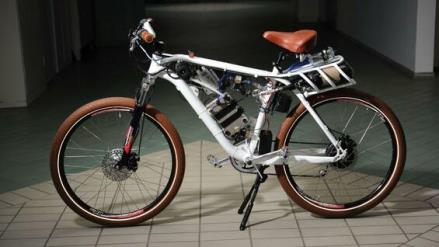 |
The development of the Gernweit Ped-Hy-lec bike began in 2008. The business consultant Holger Hanisch was supported by the Department of Hydrogen and Fuel Cell Technology of the University of Applied Sciences RheinMain, in cooperation with Ralph Luh Engineering Co. and Schunk Bahn- und Industrietechnik GmbH (all in Germany). The hydrogen bicycle had been developed until 2014. Its weight was 34.6 Kg and its price was somewhere above €7'000. |
Besides the more traditional bicycles, in 2012 futuristic prototypes were conceived by visionaries. Examples are the design model by the Swede Johan Persson for Aprilia, or the “Hydogenia”, a hybrid between pedelec, rickshaw and fuel cell from IFAM (Fraunhofer Institute for Manufacturing Technology and Advanced Materials), Dresden.
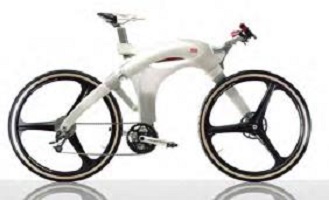 |
 |
| Johan Persson’s Aprilia, 2012 | Fraunhofer E-Bike Hydogenia, 2012 |
More recent are the prototypes of Vorradler (Germany 2014), Tc Mobility (Italy, 2015), Alex Bevan from Birmingham University (United Kingdom, 2017) with H2 internal combustion engine or the bicycle by Ankica Đukić at the University of Zagreb (Croatia, 2017).
 |
 |
| Electrolyte Vorradler S3 FC, 2014 | Tc Mobility Frisbee «Scoobi» H2, 2015 |
 |
 |
| Alex Bevan, Birmingham University, 2017 | Ankica Đukić, University of Zagreb, 2017 |
The Deutsches Zentrum für Luft- und Raumfahrt (DLR) developed a pedelec shown in 2014. This bicycle is now in their museum. DLR also developed a cargo bike. The technology is now exploited by Rytle GmbH in Hamburg, Germany.
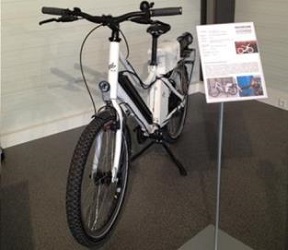 |
 |
| DLR BZ-Rad, at the DLR museum | DLR Cargo Bike, 2015 |
At the Fraunhofer Institute ISE in Germany the LiteFCBike had been developed since 2016. This complete fuel cell system with hydrogen storage in twelve metal hydride cartridges and buffer battery can be mounted on any electric bicycle replacing the battery. In combination with an electric bike conversion kit almost any bike can be converted into a hydrogen bike. The energy stored with the kit is about 270Wh, so only half of a standard pedelec battery (about 500 Wh).
 |
 |
| Fraunhofer ISE, 2016 | the hydrogen pack |
| We have not found any more information about the MicroBike E-go Hydrogen, advertised on the internet in May 2019 with a price of €4'500. |  |
Of course, we've also seen industrial manufacturers trying to commercialize hydrogen-powered bicycles.
| In November 2004, Palcan Fuel Cells Ltd. of Vancouver, Canada inaugurated its first assembly line at the Shanghai Tongji Nanhui Science and Technology Industrial Park and partnered with Nanjing Fuel Cell Company Ltd. Eventually, Palcan abandoned this business. In 2009, Palcan supplied a 300W PAC to the Chinese company Shanghai Giant & Phoenix Bicycle to power a hydrogen-scooter. |  |
The German Masterflex AG had a little more success. Suppliers of fluid handling components and analysis systems, Masterflex began to get involved in the PACs business in 2001. The prototype of its HyBike with a 250W PEM and 45 grams of hydrogen on board was shown at the Hannover Messe 2004. In 2007, the city of Herten in Germany, a champion in the application of green technologies, bought ten HyBikes for €70'000. The hydrogen was to be supplied by its "Blue Tower" factory, but apparently there were technological problems. In the meantime Masterflex built the CargoBike together with the German bicycle manufacturer Hawk Bikes Entwicklung & Marketing GmbH. The Deutsche Telekom tested 14 CargoBikes in Berlin in 2008. There was no follow up from these prototypes, and in April 2011 Masterflex announced that it had divested its bicycle business.
 |
 |
| Masterflex HyBike, 2004 | Masterflex Cargo Bike, 2008 |
| Palcan's bike has had a successor in China. In 2007 Shanghai Pearl (Shanghai Pearl Hydrogen Power Source Technology Company) presented its "Hydrogen Fuel Cell Powered Bicycle PHB". This bicycle weighed 32 Kg. Its price was estimated at $2,650 with a projection of $350 for mass production. |  |
Valeswood ETD Ltd. in Birmingham, UK, used Shanghai Pearl technology to create its own hydrogen-powered bicycle in 2007. Since 2010, Valeswood ETD Ltd. seems no longer in business.
 |
 |
| Valeswood 2007 | Valeswood 2010 |
| Another derivative of the Shanghai Pearl bicycle was marketed somewhat later by the Italian company Acta SpA. The company presented its first prototype in September 2009 at the EICMA Motor Show. The Acta bike would be used to gain experience, for example in Spain by the Fundación para el desarrollo de las nuevas tecnologias del hidrógeno en Aragón and the CCI Instituto Tecnologia de Canarias in Pozo Isquierdo, Gran Canaria, Islas Canarias. However, Acta has since abandoned this application to concentrate on the development of electrolysers. |  |
| Similar to the bikes of Shanghai Pearl, Valeswood or Acta was Iwatani's bicycle. Iwatani Corporation developed hydrogen-powered electrically-assisted bicycles between 2006 to 2008 participating in the Japan Hydrogen & Fuel Cell Demonstration Project (JHFC). The outcome was presented at the Kansai International Airport in October 2009. |  |
| Also in this category of small bikes falls that of Pedego Electric Bikes. This Californian company was working with SiGNa Chemistry in the development of a range extender for their electric bike Pedego Classic Comfort Cruise. "For every 1.5 lbs. of weight a rider carries, an additional 700 Wh is available (compared to ~350 Wh for an ultra-high performance lithium-polymer battery at a weight of 7 lbs.)." |  |
| At the same time in Austria and Germany, the company Linde at Vienna, Austria, a supplier of industrial gases and technology, was active in the field. A pilot series of one hundred hydrogen-powered bicycles was produced and distributed to institutional and political users in 2015. The bike weighs only 23.6 kg with a price tag above €7'000, but Linde is not interested in marketing it. | 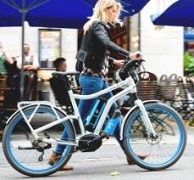 |
The French company Gitane (Cycleurope Group) presented its prototype hybrid called Alter Bike in Nice in May 2013. It had been developed in collaboration with the French companies Pragma Industries and Ventec. The hydrogen is stored in interchangeable and recyclable metal-hydride capsules. The Alter 2 bike appeared in 2016.
 |
 |
| Gitane Alter Bike, 2013 | Gitane Alter Bike 2, 2016 |
Today
The hydrogen bicycle αlpha is a development of Pragma Industries (Biarritz, France). The project is supported by ADEME. Pragma Industries had presented a prototype in 2015. These bicycles weigh 25 kg, comparable to the weight of an electric bicycle. They were given a price tag of €7'000, with the prospect of reducing the price to €3'500 by 2020. There are several projects using the αlpha such as the CARGHO project, which is a fleet of hydrogen bicycles tested by users in Chambéry and at Savoie Technolac, or also the Bhyke project in Cherbourg and Saint-Lô in the Manche with a fleet of 20 bicycles. Pragma Industries has also unveiled hydrogen eTrikes for the last meters in the delivery chain.
 |
 |
The MovR cargo bike by Rytle (Bremen, Germany) has been on the market since 2018. The company is a spin-off project of DLR's Fuel Cell Power Pack (FC PP).

Atena Scarl is the high-tech centre for energy and the environment in Italy. Its flagship technology is a small fuel-cell system that is put on hydrogen-powered bicycles, scooters and micro cars. The systems are equipped with interchangeable cartridges or can be recharged independently. The hydrogen bicycle is supported by ENEA, Università Parthenope di Napoli and Università degli Studi di Perugia. In 2019, three models were available: Touring 250, Sport MB250, Sport MB500, but without price or point of sale.

In September 2019 CYCLEUROPE and STOR-H presented the Gitane Sneaker, a hydrogen-powered three-wheeled bicycle. The electric motor has a power of 250W. Two metal hydride cartridges provide a range of 50 km. The company Aaqius, supplier of the returnable cartridges, plans to create a local network of distributors.
Sources
List of the most important web pages visited, almost complete, in alphabetical order :
blog.wired.com/gadgets/2007/05/fuel_cell_cargo.html
blog.wired.com/gadgets/2007/05/fuel_cell_cargo.html
blog.wired.com/gadgets/2007/05/fuel_cell_cargo.html
blue-rocket.de/rytle-vernetzt-lastenraeder-mit-mini-hubs/
bresciapoint.blogspot.com/2009/05/la-mobilita-ad-idrogeno-e-gia-realta.html
en.wikipedia.org/wiki/PHB_(bicycle)
evworld.com/article.cfm?storyid=413
frisbee.eu/blogs/news/19169327-bici-frisbee-a-idrogeno-by-tc-mobility
hydrogen.hr/en/first-croatian-hydrogen-fuel-cells-powered-bicycle
HZwei/blog/2018-12-14/die-letzte-meile-mit-dem-movr
Masterflex: Cargobike with mini fuel cells at Hanover Fair
mhtx.com/history/mid-range-fuel-cell/
microbike.it/Microbike-go%20Idrogeno.htm
old.enea.it/produzione_scientifica/pdf_volumi/V2002_Celle-Combustibile.pdf
phys.org/news/2018-04-hydrogen-aid.html
rideyourcity.wordpress.com/2012/03/22/fuel-cell-cargo-bike-could-power-your-lights-and-tv-too/
www.afhypac.org/documents/tout-savoir/fiche_9.4.4_les_applications_aux_cycles_rev.mai_2015_th.a.pdf
www.afhypac.org/documents/tout-savoir/fiche_9.4.4_les_applications_aux_cycles_rev.mai_2015_th.a.pdf
www.alternative-energy-news.info/hydrogen-fuel-cell-bikes/
www.alternative-energy-news.info/hydrogen-fuel-cell-bikes/
www.alternative-energy-news.info/hydrogen-fuel-cell-bikes/
www.autogazette.de/eco/wasserstoff-fahrrad-203472.html
www.bike-eu.com/home/nieuws/2013/05/launch-of-worlds-1st-hydrogen-fuel-cell-e-bike-1013039
www.bolidenforum.de/artikel/zweirad/65568-fraunhofer-pr%C3%A4sentiert-brennstoffzellen-fahrrad
www.ctsenergy.net/news/from-bolzano-to-hannover-launch-pad-for-smart-mobility/
www.dlr.de/fk/desktopdefault.aspx/tabid-3731/5826_read-41856/
www.dlr.de/fk/desktopdefault.aspx/tabid-6194/13132_read-46816/
www.dlr.de/fk/Portaldata/40/Resources//181_14_025_Flyer_Brennstoffzellen-Bike_web.pdf
www.dlr.de/ra/desktopdefault.aspx/tabid-4058/6636_read-48445/
www.ebiketestsieger.com/e-bike-news/243-weltneuheit-e-bikes-mit-wasserstoff-antrieb.html
www.elektrobike-online.com/news/e-bikes-und-pedelecs/wasserstoff-e-bike-von-linde-elektrobike-beantwortet-die-zehn-wichtigsten-fragen.1480506.410636.htm
www.energieportal24.de/artikel_1211.htm
www.fahrrad-xxl.de/blog/kommt-2019-das-wasserstoff-e-bike-mit-brose-motor/
www.fr.de/frankfurt/wasserstoff-technik-anfassen-11339038.html
www.gernweit.com/hydrogen-e-bike.html
www.gernweit.com/wasserstoff-rad.html
www.hydrogen-motors.com/hydrogen/2010/03/fuel-cell-bicycle-hydrogen-bicycle/
www.hzwei.info/blog/2016/03/14/auch-pedelecs-fahren-mit-brennstoffzellen/
www.hzwei.info/wp-content/uploads/download/HZwei-Juli-2008.pdf
www.ingenieur.de/technik/fachbereiche/antriebstechnik/paketauslieferung-per-wasserstoff-bike/
www.ise.fraunhofer.de/de/forschungsprojekte/litefcbike.html
www.iwatani.co.jp/eng/newsrelease/detail_32.html
www.lastampa.it/2009/11/05/scienza/in-arrivo-la-bici-a-idrogeno-LPntOEPnKlZXZsbyc7Kn5H/pagina.html
www.masterflex.de/com/index.php?news_id=804
www.masterflex.de/unternehmen/historie/2001-bis-2010.html
www.merlin.unsw.edu.au/energyh/hy-cycle/
www.pnp.de/nachrichten/ratgeber/auto_und_motor/sps/3200301_Das-erste-Wasserstoff-Mountainbike.html
www.poweredbicycles.co.uk/Hydrogen-Lion-Bike/G222.htm
www.poweredbicycles.co.uk/Lion-Folding-Bike-With-Hydrogen-Cell/G123.htm
www.pragma-industries.com/products/light-mobility/
www.pragma-industries.com/products/light-mobility/
www.qualenergia.it/articoli/enea-presenta-la-bici-elettrica-a-idrogeno/
www.rad-nr.de/2014/11/22/ein-drahtesel-mit-wasserstoff-antrieb/
www.solarinitiativen.de/wp-content/uploads/1_fr_02_stiller_wasserstoff.pdf
www.treehugger.com/cars/gore-aprilia-fuel-cell-bike.html
www.treehugger.com/files/2007/05/on_yer_hydrogen.php
www.valeswood.com/news/valeswood_newsletter_2010_spring.html
www.youtube.com/watch?v=Ma3CPaWTe90
www.youtube.com/watch?v=P3LPWVMB54k
www.youtube.com/watch?v=PSmH9xHxHc8
www.youtube.com/watch?v=T5wo8AvsSxQ
www.zsw-bw.de/zepeo.fsb.hr/blog/2017/07/07/ankica-dukic-presented-her-hydrogen-bicycle/
Kit pour Vélo H2
Conversion kit for hydrogen bicycle
Project description
We want to co-create a conversion kit «open source»
to transform classical bicycles into hydrogen powered electric bicycles.
Who we are ?
The project "Kit pour Vélo H2" is a project of Pangloss Labs association at Ferney-Voltaire, France. The project is one of the many co-creation projects of the members of the association.
Raison d’être : Promote green hydrogen at fair price to promote the use of renewable energy.
Hydrogen is not easily available to the individual. Today, use of hydrogen is confined to
• subsidized projects which are run by the supplyer of the hydrogen equipment,
• particular applications like vehicle fleets , and
• trained guided users like La Poste.
In this environment we lack the opportunity for doing something ourselves, for using hydrogen in our daily life. With the concersion kit for the hydrogen bicycle and a viable hydrogen distribution available, we start into a new phase in the evolution of the hydrogen economy, the one that includes the common person.
Vision
An economy in which it is easy to get green hydrogen, even in small quantities and at affordable price, for individual use p.ex. to heat, to cook or -as is presented here - to move around on a motor assited bicycle.
Mission : Promote the use of renewable energy (“appellation hydrogène verte”).
Our primary goal is the creation of a kit to convert a standard bicycle into an electric bicycle powered by hydrogen. Making a prototype will serve to raise funds for the next stage.
The second goal is proposing a regional hydrogen infrastruture which is appropriate for the needs of the cyclists, and which is easy to copy and implement elsewhere.
Batterie or hydrogen power for the electric bike ?
For short rides in town, the electric bicycle is a good solution. But when you need to move over larger distances for example in the coutnryside, the electric bike's range is often too shorts. In particular commuters between a home in the outskirts of the city and a job inside can be disadvantaged by the autonomy limited by the energy stored in the battery. With hydrogen, the range of an electric vehicle can be much larger, because more energy can be stored in comparison to batteries.
Why hydrogen ?
To achieve our environmental and climate goals we must reduce CO2 emissions massively and utilise the advantages that come with renewable energies. For the storage of renewable elecricty produced with photo-voltaic panels or wind power generators, hydrogen is being established as a primary storage medium. Surplus energy is transformed into hydrogen - rather than being discarded - which thus is available not only for reconversion into electricity but also for direct use in a multitude of applications, in particular in individual mobility. Such hydrogen is truely green as it does not impact patterns of consumption like it is the case of electricity when renewble energy for transport cuts into the supply of renewable energy to other sectors.
Why Open Source ?
The use of hydrogen applications is generally confined to organizations and professional users. One of the obstacles is the cost of the equipment. With an open source development of the conversion kit the invidual users can construct his or her own hydrogen bicycle at the cost of the components only. This entails larger numbers of users and in turn cheaper components. Feedback from users will accelerate the development.
The advantages …
- Increased autonomy because of larger energy storage on the bicycle with hydrogen than with batteires.
- Changing a hydrogen cartouche or a battery takes about thesame time of a few minutes. But recharging a cartouche (50 gr H2) or a battery (0.5 KWh) makes the difference: few minutes for the hydrogen but hours of the battery.
- Reduction, even elimination, of the hazardous materials in the batteries.
- Hydrogen storage does not leak. There is no auto-discharge like it is observed with batteries.
- The H2 bike has a greater lifetime that the battery electric bike.
- The price of the conversion kit can be comparatively low. Therefore the hydrogen bicycle will come with an interesting price tag.
- Potentially lower operational cost and therefore an advantageous TCO (Total Cost of Ownership) compared to battery-electric bicycles - once investment cost is reduced. (R. Berger, “Business case for FC-electric bikes”, FCH 2 JU, 2017)
- A heat-exchcanger at the fuel cell can be integrated into the bike. The heat can be used to warm seat and handles. Or for heating a metal hydride cartouche.
- Today, the weights of hydrogen and battery electric bicycles is not much different. With the conversion kit the weight of the hydrogen bicycle possibly can be further reduced.
- Both hydrogen and battery electric bicycles produce no other emissions than water vapour, they are « zéro émission » vehicles.
- Hydrogen and battery electric bicycles are particularly quiet.
- Eventually it will be possible capturing energy from breaks or when rolling downhill with a reversible fuel cell.
… and the disadvantages
- Primary energy consumption is approximately twice as that of an electric bicycles (conversion efficiency e- → H2 → e-) for the same autonomy.
- There is no appropriate hydrogen distribution, neither for small gas bottles nor for metal hydride containers. Electrolysers are expensive.
- The price of hydrogen is (still) high because of the investments for the infrastructure.
The challenges
Fuel cells exist. We need to find the right fuel cell for use on the bicycle.
We need to find appropriate, i.e. cheap, light and compact hydrogen storage either as compressed gas in a bottle or dissolved in a metal hydride container.
We need to create the hydrogen infrastructure (storage container leasing, vending machines, centralized or individualized recharge) ?
Some links :
questions FAQ
The H2 Bicycle – A Step Towards A Cleaner Future
During the Open Geneva Innovation Festival 2018 a group of Pangloss members and others assembled to think about how to introduce hydrogen as a clean energy vector in our society. Various ideas were aired. A condensation took place for the Fête de la Science in Ferney-Voltaire half a year later. One of the concepts put forward was that of bringing hydrogen bicycles to the people. Two workshops (hackathons) on the subject followed in January and March 2019.
The hydrogen powered electric bicycle (HPEB) is not a new idea. Already 20 years ago such vehicles were constructed, but they were never made available to the common person, not to talk about production in series. The latest version, the Alpha bike of French company Pragma Industries is produced in batches of a hundred units and distributed to users, usually organizations, who can afford the rather hefty price of the bicycle of the order of 7'000 euros and the massive cost of a refilling station upwards of 50'000 euros.
At Pangloss Labs we have the idea to make all this cheaper with the goal to enable everybody profitting from green energy and clean hydrogen thus making a measurable contribution to a more sustainable world.
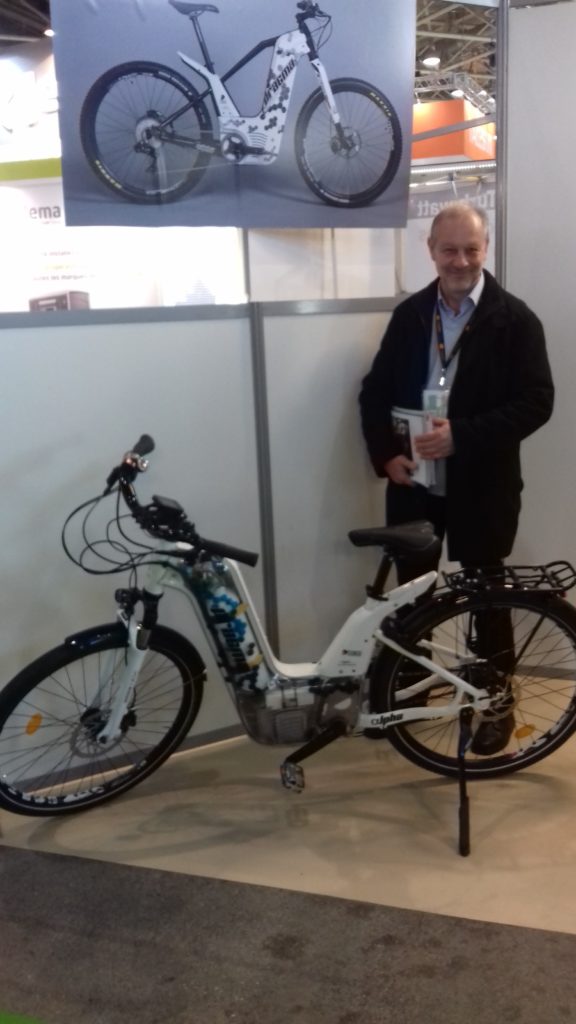
Our concept turns around the creation of a kit for converting normal bicycles into hydrogen powered electric bicycles (HPEB). Such kits should be cheap. The HPEB should not cost more than the equivalent electric bike but - and this will be the major advantage for the cyclist - with much larger autonomy. We think that eventually we can store 50 grams of hydrogen on the bike, which is equivalent to 750 Wh using a decent fuelcell, 50% more energy than typically stored on an electric bicycle. Bigger hydrogen containers and more efficient fuel cells will soon bring the advantage to 100% doubling the autonomy.

Closing the loop: Innovation for a Circular Economy
Pangloss @ #UNHCRNGOs
Solar Thermal Hydrogen Production – An Adventure
The Business Benefits of Open Source Modular Design
Business Benefits of Open Source Modular Design
Sustainable Development Lab
The Sustainable Development lab is where we try to improve the way we do things to ensure a better future for us all. Projects range from renewable energy, to new repair techniques, to education, to re-localising production and beyond.
From an entrepreneurial perspective, if you're looking for problems to solve, the UN has co-created a list of seventeen goals that they are trying to achieve by 2030. It will need most everyone in the world to actually do this, so there are plenty of opportunities.
The Sustainable Development Goals
Recent Sustainable Development Lab Projects
Lab Manager(s)
Paul Bristow
Innovation Consultant | Open Source Expert












